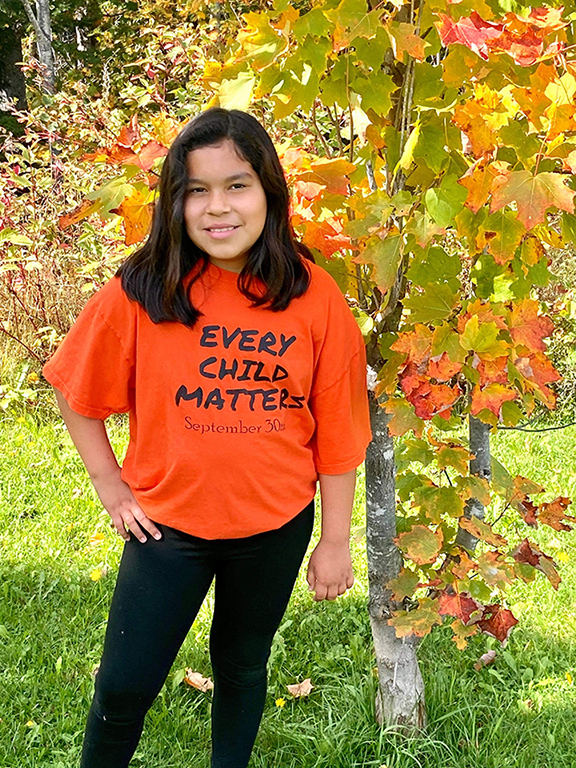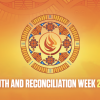-
Truth and Reconciliation Week: The Future
“This road started well before Indigenous children were forced to attend these schools, when Indigenous Nations flourished, their laws and languages were intact. Despite the recent history of racism and cruelty, today our path is focused on healing and resurgence – on the Land and in our Homes,” National Centre for Truth and Reconciliation, 2021.
Indigenous people are revitalizing their traditions, languages and their culture. An example of this is world recognized Stephen Jerome who makes traditional, ancestral black ash baskets in Gesgapegiag. He learned this skill from his father, and he is passing the skill on to the next generation. Indigenous artists create their works with pride of their culture and history.
The preservation and resurgence of Indigenous culture, including languages, art and ways of life are increasingly being steered by community-level decisions and the active participation of that community.
Educational settings, including the teaching of Indigenous culture and worldviews is being developed and adapted. This includes post-secondary degree programs that have been Indigenized and are taught in the home community.
In all areas of Canadian society, Indigenous people are promoting their identities and their rights.
Some Indigenous communities are making great progress towards reaching social, economic and cultural goals by developing local entrepreneurship. The Pow Wow Pitch is a pitch competition for Indigenous entrepreneurs across Turtle Island (North America). This year more than 1,600 Indigenous entrepreneurs pitched their businesses, including Gesgapegiag resident Christianne Jerome Bernard, for an opportunity to win prizes from $500 to $25,000.
First Nations, Inuit and Metis peoples are making greater strides toward self-determination. This includes the right to pursue “Their economic, cultural, and social development and to govern their affairs.”
In the future, decision-making will be more collaborative and participatory and led by Indigenous communities.
“As First Nations, Inuit and Métis communities access and revitalize their spirituality, cultures, languages, laws and governance systems, and as non-Aboriginal Canadians increasingly come to understand Indigenous history within Canada and to recognize and respect Indigenous approaches to establishing and maintaining respectful relationships, Canadians can work together to forge a new covenant of reconciliation,” Truth and Reconciliation Commission, 2015
“Because when you’re robbed of your childhood, and you’re not connected to your parents, which many of the survivors — all of the survivors — went through, you lose that connection around parenting and family. Those things must be rebuilt with each generation. So, we’ve got to find a way to heal that and have families become healthy and strong again and reach our vision of happy, healthy children surrounded by love and care of their families in safe and vibrant communities. That’s what we want. Everybody wants that across this country. And I really believe that an Indigenous-healing fund is one mechanism to contribute to that healing. … and make sure that we’re creating a society, and a country, where this thing never happens again,” RoseAnne Archibald, National Chief of the Assembly of First Nations, 2021
“We welcome this “Sacred Day of Reconciliation” and we appreciate all the support demonstrated by the people. It is sacred because we believe that all life is sacred and especially the lives of our children. The policy of assimilation and extinguishment of our culture, languages, spiritual beliefs, and dispossession of our territories, should never be forgotten and needs to become mainstream curriculum. This day of remembrance should be used to learn from the past so that these ongoing policies by federal and provincial governments come to an end and that our people and our rights be recognized and that we establish a true government to government relationship based on the truth. Reconciliation also means reparation,” John Martin, Chief of Gesgapegiag
-
Truth and Reconciliation Week: Orange Shirt Day – September 30
“The colour orange always reminded me how my feelings didn’t matter, how no one cared and how I felt like I was worth nothing. All of us little children were crying, and no one cared,” Phyllis Webstad
Phyllis Webstad is from the Stswecem’c (Canoe Creek) Xgat’tem (Dog Creek) First Nation. When she was six years old, she was sent to St. Joseph’s Mission Residential School in B.C. She wanted to look nice, so she chose to wear an orange shirt given to her by her grandmother. When she arrived at the school her orange shirt was taken from her, and she was forced to wear a uniform. This was just the beginning of the many things that were taken from her and all children who entered residential schools.
In 2013 Phyllis Webstad started Orange Shirt Day to remind people about the abuse and neglect that the children suffered. Wearing an Orange Shirt honours the children who did not come home and the survivors, their families and their communities.
Orange Shirt Day (Truth and Reconciliation Day) 2021 is now a federal holiday, with postal workers, federal government staff and bank employees getting the day off. The day is one of reflection on atrocities committed against Indigenous peoples. Only three provinces have designated the day as an official holiday. In provinces where it is not designated, it is up to employers whether to give the day off. In Quebec, September 30 is not a provincial holiday.
Orange Shirt Day is a symbol of the “stripping away of culture, freedom and self-esteem experienced by Indigenous children over generations.”
On this day:
- Wear an orange shirt purchased from an Indigenous company (Mi’kmaq Printing and design at www.mikmaqprinting.com).
- Read and reflect on the Truth and Reconciliation Commission Report 94 calls to action. Google: 94 Calls to Action
- Donate $30 to a local or national Indigenous organization working to improve the lives of children, families, individuals and communities.
- Watch online events hosted by the National Centre for Truth and Reconciliation.
- 48 books by Indigenous Writers to read to understand residential schools – article available online at CBC Books, June 10, 2021.
- Read Phyllis Webstad’s book, The Orange Shirt Story.

Melody Condo of Gesgapegiag proudly wearing her Orange Shirt. Credit: Christianne Bernard
